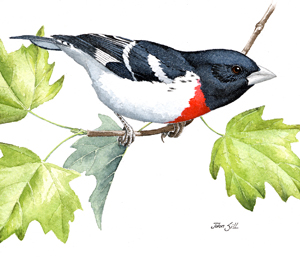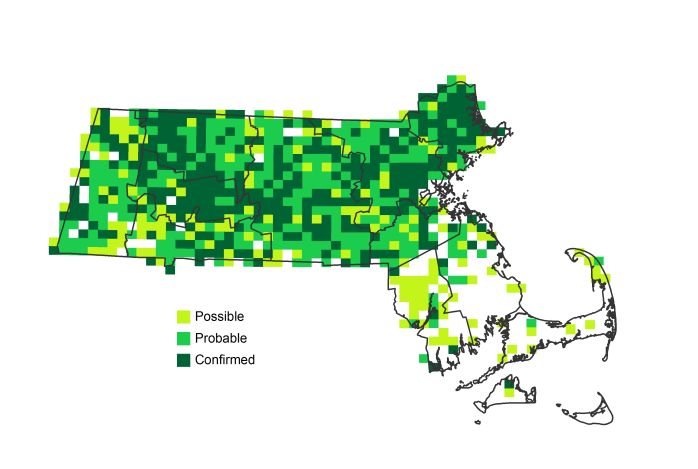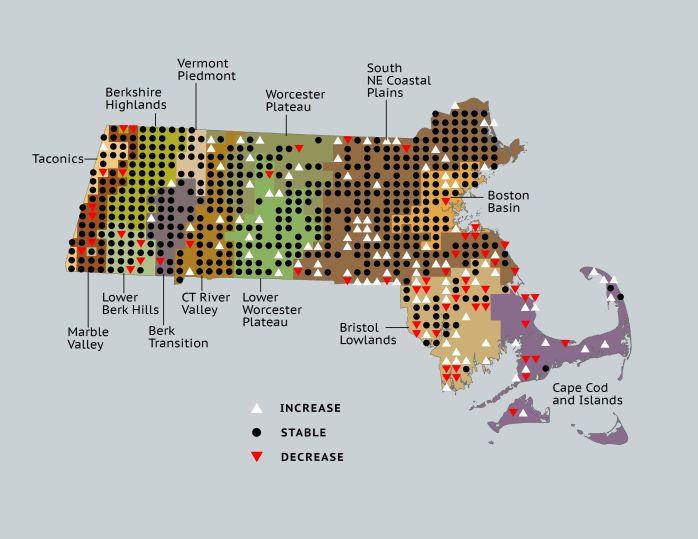Find a Bird
Rose-breasted Grosbeak
Pheucticus ludovicianus

Very widespread and likely increasing
Action/monitoring needed
“Saw two splendid rose-breasted grosbeaks with females in the young wood in Emerson’s lot. What strong-colored fellows, black, white, and fiery rose-red breasts!” – Henry David Thoreau, Thoreau’s Bird Lore
Bird species that breed in disturbed forest have a friend in humankind. This illustrates an interesting aspect of people’s relationship with other species. Birds and other organisms that can thrive in maturing wooded suburban landscapes and parks, despite the fragmentation caused by roads and the introduction of human-associated predators, are doing well in the current landscape of Massachusetts. The Rose-breasted Grosbeak is iconic in this category. The species was historically found in parks, wooded backyards, along shady suburban roadways, and in landscaped cemeteries, and today the Massachusetts range of this bird seems to be increasing because of the changes we have wrought upon the landscape. Despite this, however, the possibility of a quiet decline in this handsome species should not be discounted.
Historic Status
Beautifully plumed and decidedly mellifluous in song, the Rose-Breasted Grosbeak is a bird whose population has had its ups and downs. Forbush believed the species’ numbers grew during the 1800s in Massachusetts. Denizens of deciduous forests, they adapted well to the creation of farmland, so much so that they were sometimes known to specialize on the larvae of the Colorado potato beetle (Forbush 1927). On the other hand, the targeting of cultivated peas and fruits, and the buds and flowers of trees by this species labeled it as a sometimes pest. During the early 1900s, it was the beautiful voice of the Rose-breasted Grosbeak that condemned it, as it became a popular cage bird in its wintering range during that period (Bent 1968). The cage trade now long over, in the modern era it seems to have adapted well to suburbanization.
Atlas 1 Distribution
Rose-breasted Grosbeaks were widespread in Atlas 1, finding homes in 63% of the blocks surveyed, with particularly noteworthy concentrations in the western part of the state. The Marble Valleys reported evidence of breeding Rose-breasted Grosbeaks in every single block; in fact, no region west of the Worcester Plateau had less than 70% block occupancy. The Worcester Plateau had somewhat fewer occupied blocks than the surrounding regions, but still had a widely distributed Rose-breasted Grosbeak presence. The grosbeaks were fairly widespread throughout the Coastal Plains and Hills, but were fewer in the Bristol/Narragansett Lowlands, and almost absent from the Cape and Islands. The forests of Pitch Pine and scrub oak in the southeast likely failed to meet the needs of the grosbeaks, which prefer moist, mixed woods with occasional openings and a stronger deciduous component.
Atlas 2 Distribution and Change
Maturing suburban landscapes and forests likely aided the expansion of Rose-breasted Grosbeaks during the Atlas interval, and their block occupancy shot up to 73%. The westernmost ecoregions were near saturation during Atlas 1, and remained so in Atlas 2. The Connecticut River Valley and the regions eastward showed notable gains for this species, especially the Worcester Plateau. Throughout the Coastal Plains, new Rose-breasted Grosbeak blocks were easy to come by, and losses were concentrated along the border with the Bristol/Narragansett Lowlands. The Bristol/Narragansett Lowlands and Cape Cod and the Islands showed only small net increases.
Atlas 1 Map

Atlas 2 Map

Atlas Change Map

Ecoregion Data
Atlas 1 | Atlas 2 | Change | ||||||
Ecoregion | # Blocks | % Blocks | % of Range | # Blocks | % Blocks | % of Range | Change in # Blocks | Change in % Blocks |
Taconic Mountains | 14 | 87.5 | 2.3 | 23 | 92.0 | 3.0 | 0 | 0.0 |
Marble Valleys/Housatonic Valley | 39 | 100.0 | 6.4 | 34 | 87.2 | 4.5 | -5 | -12.8 |
Berkshire Highlands | 53 | 96.4 | 8.7 | 53 | 96.4 | 7.0 | -1 | -1.9 |
Lower Berkshire Hills | 27 | 96.4 | 4.4 | 23 | 74.2 | 3.0 | -4 | -14.8 |
Vermont Piedmont | 12 | 70.6 | 2.0 | 17 | 100.0 | 2.3 | 0 | 0.0 |
Berkshire Transition | 34 | 89.5 | 5.6 | 38 | 95.0 | 5.0 | 0 | 0.0 |
Connecticut River Valley | 47 | 83.9 | 7.7 | 60 | 92.3 | 7.9 | 5 | 10.4 |
Worcester Plateau | 50 | 64.1 | 8.2 | 82 | 93.2 | 10.9 | 9 | 18.8 |
Lower Worcester Plateau | 57 | 77.0 | 9.4 | 77 | 96.3 | 10.2 | 6 | 11.1 |
S. New England Coastal Plains and Hills | 186 | 68.9 | 30.5 | 243 | 85.9 | 32.2 | 26 | 11.5 |
Boston Basin | 34 | 60.7 | 5.6 | 37 | 66.1 | 4.9 | 3 | 5.5 |
Bristol and Narragansett Lowlands | 44 | 41.5 | 7.2 | 50 | 43.9 | 6.6 | 4 | 4.0 |
Cape Cod and Islands | 12 | 8.8 | 2.0 | 18 | 12.5 | 2.4 | 4 | 3.3 |
Statewide Total | 609 | 62.8 | 100.0 | 755 | 72.8 | 100.0 | 47 | 5.7 |
Notes
Despite this apparent Atlas increase in footprint, the Rose-breasted Grosbeak shows a significant decreasing Breeding Bird Survey (BBS) trend in the New England/Mid-Atlantic Region and the Eastern US overall. They fall into our “whispering bird” category – those species with a demonstrated stable or increasing breeding footprint from Atlas 2 data, but also a demonstrated decline in abundance from the BBS. This drives our final assessment that this is a species with a need for further monitoring and conservation action.



